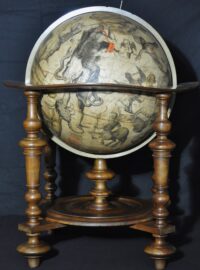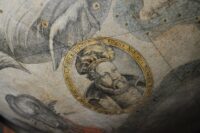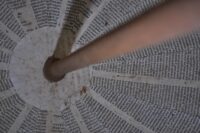 A rare 17th century celestial globe in the collection of the Museo Galileo in Florence has been restored to its former glory after six months of study, cleaning and repair. The conservation restored the full legibility of the globe, bringing back the vivid colors and details of the imagery and text.
A rare 17th century celestial globe in the collection of the Museo Galileo in Florence has been restored to its former glory after six months of study, cleaning and repair. The conservation restored the full legibility of the globe, bringing back the vivid colors and details of the imagery and text.
The Globe Celeste was begun by Joost de Hondt, aka Hondius, in 1611. Hondt was one of the three preeminent cartographers in Amsterdam at a time when the constant flow of new geographic information made the creation of updated maps and globes a highly profitable business. When he died in 1612, his son Jodocus Hondius the Younger completed the globe with Adriaen Veen. Dedicated to the “lords of the United Provinces of Belgium,” the celestial globe depicts the constellations and stars, using the ancient observations of Claudius Ptolemy as the base, but with major updates from astronomers  and explorers of the Age of Discovery, including the stars north of the Tropic of Capricorn observed by Tycho Brahe, whose portrait is on the globe, and the new southern hemisphere constellations first documented by Pietre Diercksz Keyser and Frederick de Houtman.
and explorers of the Age of Discovery, including the stars north of the Tropic of Capricorn observed by Tycho Brahe, whose portrait is on the globe, and the new southern hemisphere constellations first documented by Pietre Diercksz Keyser and Frederick de Houtman.
The globe is made of 12 strips of paper 5.5 inches wide at their widest points. Each strip is divided into two parts and topped with circular caps on the ends. They were printed with meticulously detailed copper plate engravings and then colored in with pigments and dyes after assembly over a spherical shell with a single axis supporting it in the interior. It was then coated in protective lacquer of shellac or another natural resin to allow the globe to be handled without damaging the surface.
 The restoration has revealed new information about the structure of the globe. It was built up from a tiny nucleus just a few millimeters in diameter. Nineteen layers later, they had a globe 21 inches in diameter. Once it was dry, a small opening was made and the material inside crushed and removed. An oak plank was then inserted through the ends and fixed with brass pins to keep the sphere’s axis stable.
The restoration has revealed new information about the structure of the globe. It was built up from a tiny nucleus just a few millimeters in diameter. Nineteen layers later, they had a globe 21 inches in diameter. Once it was dry, a small opening was made and the material inside crushed and removed. An oak plank was then inserted through the ends and fixed with brass pins to keep the sphere’s axis stable.
Researchers found no documentation of past restorations, so they deployed non-invasive techniques like ultraviolet fluorescence, false color infrared and X-rays to identify materials used in the original and in past interventions.
The surface of the globe had at least two depressions potentially caused by accidental falls, as well as areas where rubbing and scratches were evident, making the images and constellations difficult to decipher. Delicate cleaning enabled the recovery of the original shades of the constellations painted in yellow, red, green, blue, and brown, restoring the beauty of the images.
In order to reposition the paper cover more accurately, it was decided to completely remove the strip of paper and lift the cap to see inside the globe, where new observations were made on the nature and thickness of the layers, as well as the surprise discovery of a twig of willow wood with two tied paper parcels that were most likely inserted to improve a depression in the paper during a restoration of which there had previously been no record. It was decided to remove the twig, given it no longer served a use and was not part of the original structure, and the paper parcels revealed a folded piece of newspaper dated December 24, 1942, indicating that it was restored in those years.